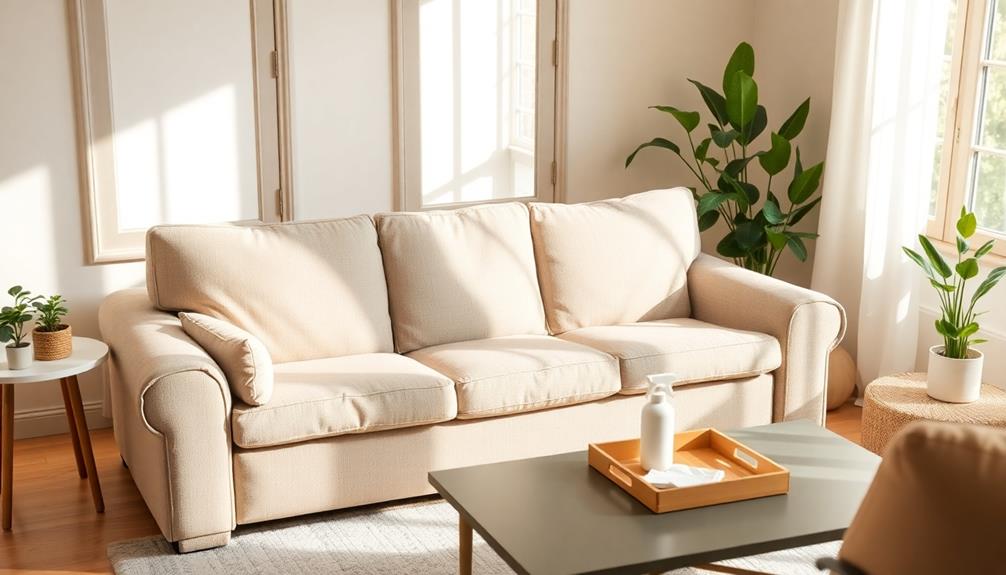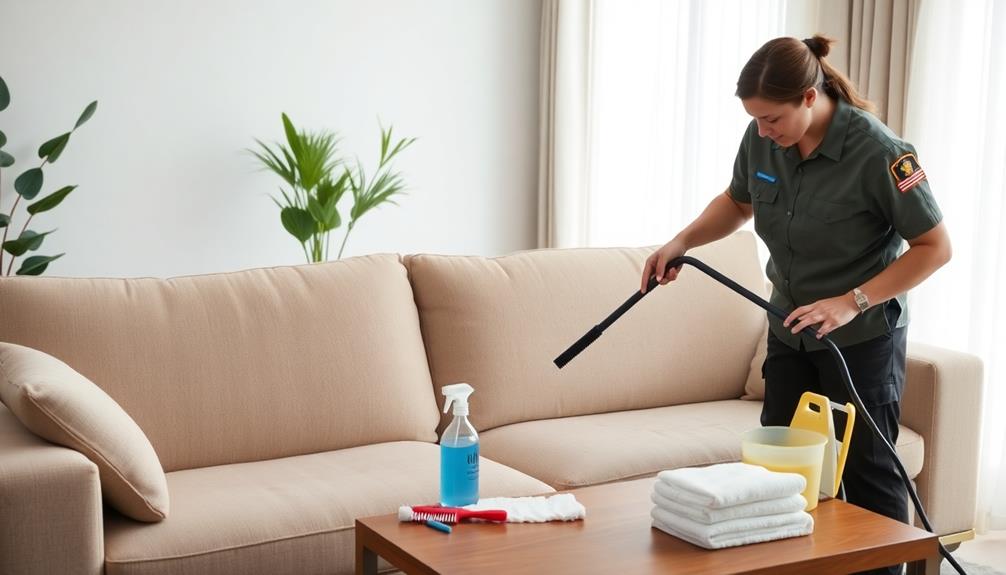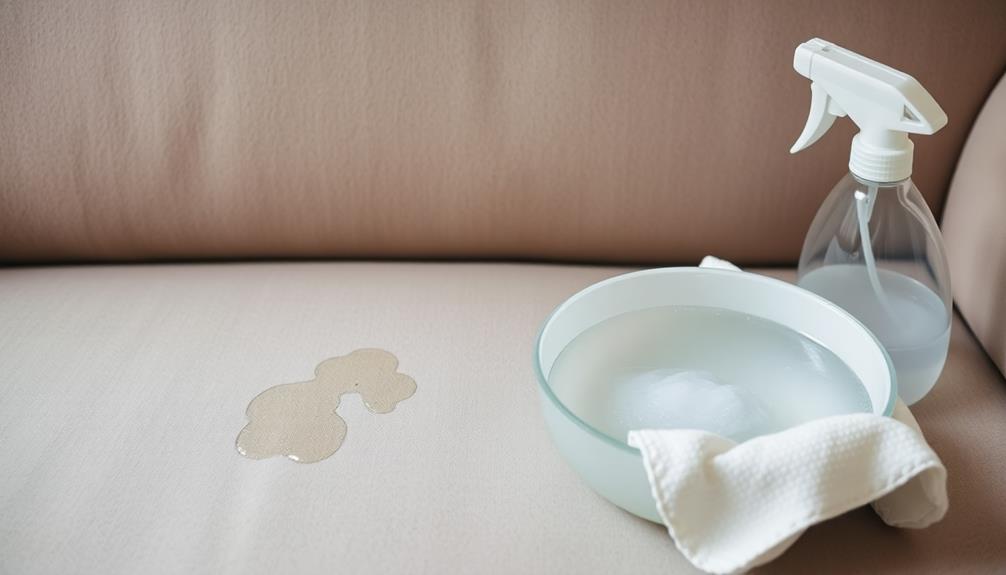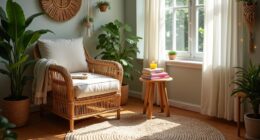You can easily eliminate water stains from your fabric couch by taking swift action. Start by patting the stain with a clean, dry cloth to absorb any excess moisture. Next, moisten a fresh cloth with distilled water and gently blot the stain. If the marks are stubborn, mix equal parts white vinegar and distilled water, apply it, and blot until the stain fades. Remember to always test any solution on a hidden spot to prevent damage. After cleaning, allow the fabric to fully dry before evaluating the outcome. If you are interested in learning more tips and techniques, there is plenty more to explore!
Key Takeaways
- Blot the water stain immediately with a clean, dry cloth to absorb excess moisture and prevent further setting.
- Dampen a cloth with distilled water and gently dab the stain to fade it before applying any solutions.
- Use a mixture of equal parts white vinegar and distilled water; spray and blot gently to lift the stain.
- For persistent stains, mix mild dish soap with distilled water, apply with a cloth, and blot dry.
- Always test cleaning solutions on an inconspicuous area of the fabric to prevent damage or discoloration.
Understanding Water Stains

Water stains on your fabric sofa can be frustrating, especially when they disrupt the overall look of your living space. These stains happen when water droplets seep into the fabric, leaving behind mineral deposits that create noticeable discoloration.
If your sofa is light-colored, you might find these stains even more pronounced, making them a common issue in upholstery maintenance. In addition to water stains, using essential oils like eucalyptus oil can help maintain the freshness of your upholstery, as it acts as a powerful decongestant that clears the air and reduces odors.
You might encounter water stains from various sources, such as spills from wet glasses, leaks, or water rings left by condensation. Understanding the nature of the stain is vital for determining the right approach to removing water stains.
Factors like the stain's age and the specific type of fabric on your sofa will influence the effectiveness of your treatment method. Acting quickly is essential. If you delay, those stains can set in, leading to permanent discoloration and possibly inviting mold or mildew into the fabric.
Importance of Timely Removal

Acting quickly when it comes to water stains can make all the difference in maintaining your fabric sofa's appearance. Timely removal is essential, as it helps prevent discoloration and guarantees the fabric retains its original look. The sooner you address spills, the less likely you're to deal with permanent water marks, which become increasingly difficult to eliminate over time.
Additionally, understanding the potential common types of cold medications can help you choose the right approach to cleaning, especially when using solutions that may come into contact with your sofa.
Wet stains create an environment ripe for mold and mildew growth, which can't only compromise your sofa's integrity but also trigger allergies in sensitive individuals. By taking prompt action, you can avoid these health risks and preserve the overall quality of your upholstery.
Additionally, addressing water stains early enhances the longevity of your fabric, ultimately saving you money on potential repairs or replacements. Quick removal also prevents mineral deposits from settling into the fabric, which can make stains more prominent and harder to treat down the line.
Initial Cleaning Steps

When tackling water stains on your fabric sofa, start with three essential initial cleaning steps. These steps will help you manage the stain effectively without causing further damage.
It's important to remember that using professional cleaning services for upholstery can enhance the longevity of your furniture and restore its appearance, much like how mechanic shops for fuel injection cleaning guarantee peak vehicle performance.
- Vacuum the Sofa: Begin by vacuuming the sofa to remove loose dirt and debris. This prevents any particles from complicating the stain removal process.
- Blot the Stain: Take a clean, white cloth and gently blot the water stain. Avoid rubbing, as this can spread the stain and worsen the situation.
- Dampen a Cloth: Next, dampen another clean cloth with distilled water. Gently dab the stained area, continuing until you see some fading of the mark.
- Soap Solution (if needed): If the stain persists, mix a small amount of mild dish soap with distilled water. Apply this solution to the stained area using a clean cloth and blot dry to help lift the stain.
Always remember to test any cleaning solution on an inconspicuous area of the fabric before applying it to the stain. Following these initial cleaning steps will set the stage for effective stain removal.
Recommended Cleaning Solutions

When it comes to removing water stains from your fabric sofa, choosing the right cleaning solution is essential.
Regular maintenance of your furniture, much like the upkeep of an air purifier, can greatly enhance its longevity and appearance. You can opt for effective stain removal products or whip up homemade cleaning solutions that tackle the job just as well.
For instance, air purifier maintenance can guarantee a healthier living environment and may help prevent future stains from allergens and dust.
Let's explore some top recommendations to help you restore your sofa to its original condition.
Effective Stain Removal Products
If you're tackling water stains on your fabric sofa, choosing the right cleaning solution can make all the difference. With various effective stain removal products available, you can efficiently remove water stains without damaging your upholstery.
Proper care and maintenance are essential for extending the life of your furniture, much like the importance of regular health checks in ultimate hamster care.
Here are some top recommendations:
- Folex Carpet Spot Remover: Highly rated for its effectiveness, this product can tackle water marks along with other stains, making it a favorite among users.
- Bac-out Stain and Odor Remover: An eco-friendly option, it's perfect for allergy sufferers and doesn't require rinsing after application, simplifying your cleaning process.
- 50:50 Mixture of White Vinegar and Distilled Water: This homemade solution is great for treating water stains, as vinegar effectively neutralizes and lifts stains without harming fabric.
- Steam Cleaning Machines: These can be particularly effective for water stain removal since the heat helps lift stains while sanitizing the fabric.
Don't forget to take into account using Scotchgard after cleaning to protect your upholstery from future stains.
These effective stain removal products will help keep your fabric sofa looking fresh and clean!
Homemade Cleaning Solutions
Homemade cleaning solutions can be a game-changer for tackling water stains on your fabric sofa. One effective method is a 50:50 mixture of white distilled vinegar and water. Simply spray this solution onto the stained area and blot it gently with a clean cloth to remove the stains.
Many homeowners appreciate the affordability and effectiveness of these methods, similar to how budget-friendly options for vacuum cleaners can help maintain a spotless home. Another option is to mix mild dish soap with distilled water. Dab this mixture onto the stain and gently scrub with a microfiber cloth for the best results.
If you prefer something stronger, consider using rubbing alcohol diluted with water. Spray it on the stained area, then gently brush and blot to lift dirt and moisture.
For quick clean-ups, baby wipes like Huggies can be surprisingly effective at removing fresh stains without needing additional cleaning solutions.
Before using any homemade cleaning solution, always test it on an inconspicuous area of the fabric first. This guarantees that it won't cause any discoloration or damage.
With these simple homemade solutions, you'll be well-equipped to remove water stains and keep your fabric sofa looking fresh and clean!
Step-by-Step Stain Removal

Blotting the water stain with a clean, dry cloth is the first essential step in removing it from your fabric sofa. This helps absorb excess moisture without rubbing, which can spread the stain further.
Follow these steps for effective stain removal:
- Dampen another cloth with distilled water and gently dab the stain. Keep doing this until you see some fading; distilled water won't introduce any minerals that could worsen the stain.
- Mix equal parts distilled white vinegar and water in a spray bottle. Spray it on the stain and let it sit for 5-10 minutes. Blot with a clean cloth to lift the stain from the upholstery.
- If the stain persists, use a mild dish soap mixed with distilled water. Apply it with a cloth, then blot dry, repeating the process as necessary until the stain is gone.
- For stubborn stains, consider using rubbing alcohol on a cloth. Dab the area carefully, ensuring you blot rather than scrub to protect your fabric.
Fabric Considerations

Before you start cleaning, check the label on your fabric sofa to see what cleaning methods are safe. Different fabrics require different approaches, so it’s important to follow the specific instructions provided. For instance, when cleaning a polyester sofa, you might be able to use a water-based cleaner, while other materials could require dry cleaning alternatives. Always test your cleaning solution on a small, inconspicuous area first to ensure it won’t damage the fabric. If the fabric is safe for water-based solutions, you can proceed with gentle spot cleaning or use a steam cleaner if recommended by the manufacturer. However, when **cleaning a polyester sofa**, avoid using excessive water, as it can saturate the cushions and potentially lead to mold or mildew growth. Always let the sofa dry completely after cleaning to ensure no moisture remains trapped in the fabric.
Understanding the fabric type is key to choosing the right approach for stain removal, as different materials may react differently to cleaning products.
You might also want to contemplate using energy-efficient appliances for any related cleaning tasks, as they can help reduce overall energy consumption.
You'll want to test any cleaning solution on a small, hidden area first to make sure it doesn't cause any damage or discoloration.
Fabric Compatibility Check
Checking the compatibility of your fabric is essential for effective stain removal. Before you reach for those water-based cleaners, take a moment to examine the cleaning label on your sofa. This label can guide your cleaning efforts by revealing compatibility codes.
Understanding the importance of common financial terms can also help you allocate resources for proper cleaning supplies.
Follow these steps for a successful fabric compatibility check:
- Read the Cleaning Label: Look for codes like W (water-based), S (solvent-based), WS (water and solvent), or X (vacuum only). These will inform you what cleaning methods are safe.
- Evaluate the Fabric Type: Fabrics like microfiber may have different cleaning requirements compared to suede or velvet. Knowing this can help you choose the right product.
- Conduct a Spot Test: Always test any cleaner on a small, inconspicuous area first. This spot test guarantees that your chosen solution won't damage or discolor the fabric.
- Allow for Drying Time: After cleaning, let the fabric dry completely. This helps you assess whether the stain removal method was effective and prevents residual moisture issues.
Testing Cleaning Solutions First**
It's vital to test cleaning solutions on your fabric sofa before applying them broadly. Start by checking the cleaning label on your sofa. Look for designations like W, S, WS, or X to understand which cleaning methods are safe for your upholstery fabrics.
Once you know your fabric's compatibility, it's time for a spot test. Incorporating mindfulness practices can help you stay patient during this process. Choose an inconspicuous area and apply a small amount of the cleaning solution.
Wait for the test area to dry completely before evaluating the results. Some stains might look different when wet, so patience is key. This step is important for ensuring that the cleaning solution won't cause discoloration or damage to your fabric sofas.
Consider the type of fabric you're dealing with, as delicate upholstery fabrics may require milder solutions or even professional cleaning services.
Preventive Measures

To keep your fabric sofa looking pristine and free from water stains, consider implementing a few simple preventive measures. By being proactive, you can avoid the hassle of dealing with stains later on.
Here's a list of effective strategies:
1. Apply a Fabric Protector: Use products like Scotchgard to create a barrier against water stains and spills. This will help your sofa resist moisture and dirt.
Additionally, similar to how best soil for string of hearts plants can enhance plant health, a good fabric protector maintains the integrity of your sofa.
2. Establish a Cleaning Schedule: Regularly vacuum and clean your sofa to prevent the buildup of dirt and stains. Stick to a consistent routine to maintain its appearance.
3. Blot Spills Immediately: When a spill occurs, quickly blot it with a clean, dry cloth. This minimizes the risk of water stains setting in and makes cleanup easier.
4. Opt for Removable Cushion Covers: Whenever possible, choose sofas with removable cushion covers. This makes washing and maintaining your upholstery much simpler.
Additionally, always use distilled water for cleaning. This avoids introducing minerals that can worsen existing stains.
Professional Cleaning Options

When dealing with stubborn water stains on your fabric sofa, considering professional cleaning options can be a game changer.
Professional cleaning services, like Master Clean Carpet Care, use specialized techniques such as Hot Water Extraction and neutralizing agents designed to remove stains effectively without damaging delicate upholstery.
These experts assess the fabric type and stain nature before selecting the most appropriate cleaning method, ensuring you get excellent results tailored to your specific situation.
With their advanced equipment and cleaning solutions, they can tackle older or set-in stains that might be impossible to eliminate with DIY methods.
Many professional cleaners also offer satisfaction guarantees, giving you peace of mind that those tough stains will be addressed effectively.
If you've got a busy schedule or a particularly challenging stain situation, professional cleaning can save you time and effort, allowing you to enjoy your sofa without the stress of trying to clean it yourself.
When you choose a professional service, you're investing in the longevity of your sofa while ensuring it looks its best.
Don't hesitate to reach out for help when those water stains refuse to budge!
User Experiences and Tips

Many users have discovered effective strategies for removing water stains from fabric sofas, sharing their personal experiences and tips. If you're facing this issue, consider these tried-and-true methods:
- Vinegar Solution: Mix equal parts of white vinegar and distilled water in a spray bottle. Lightly spray the area, then blot with a clean cloth to remove the water and stain.
- Steam Cleaning: Many users report that using a professional-grade steamer markedly improves stain visibility. This method can be particularly effective for older stains.
- Immediate Action: Address spills as soon as they happen. Users note that quick responses yield the best results in preventing stains from setting.
- Baby Wipes: Some individuals swear by using Huggies baby wipes to lift minor water stains. They're gentle on fabric and can be quite effective.
Be cautious with bleach, as it can discolor and damage fabric. Always test on a hidden area first.
With these insights, you can confidently tackle those pesky water stains and restore your sofa's appearance!
Frequently Asked Questions
How to Get Water Stains Out of Fabric Couch?
To get water stains out of your fabric couch, start by gently blotting the area. Then, use a vinegar-water solution, apply it, let it sit, rinse, and blot until the stain lifts.
Can Water Stains Be Removed From Fabric?
Absolutely, you can banish those pesky water stains from fabric like they're nothing! Just remember, the sooner you tackle them, the better your chances are for a spotless finish. Don't forget to test any cleaner first!
Does Baking Soda Remove Water Stains on Upholstery?
Baking soda can help with water stains on upholstery, but it might not completely eliminate them. Sprinkle it on the stain, let it absorb, and vacuum it up for better results. Always test first!
How Do You Fix a Water Damaged Couch?
To fix a water-damaged couch, you should immediately blot the area with a dry cloth. Then, apply a vinegar solution to the stain, let it sit, and blot again for best results.
Conclusion
You might think removing water stains from your fabric sofa is an intimidating task, but it doesn't have to be! With the right approach and a few simple steps, you can restore your sofa to its former glory. Don't let a little water damage discourage you—take action now! By following our guide, you'll not only eliminate the stains but also protect your sofa from future mishaps. Jump in and give your furniture the care it deserves!









